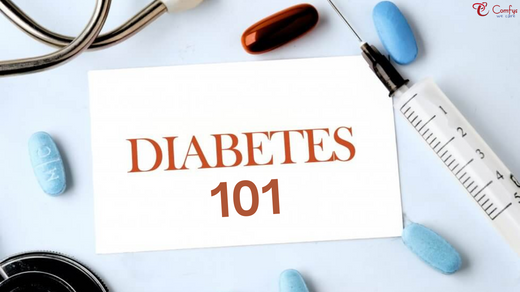Diabetes is a condition in which the level of sugar/glucose in the blood is higher than normal. According to the World Health Organisation, Normal blood sugar for a person who has not eaten for 8–10 hours (fasting blood sugar) is 126mg/dL or 7.0 mmol/L.

Normal and High blood sugar in blood: courtesy of NIDDK
Types of Diabetes
Type 1 diabetes
This is a type of diabetes where the body completely stops producing insulin due to destruction of the insulin-producing pancreatic cells by the body’s immune system.
Type 2 diabetes
Here, the pancreas either produces inadequate amounts of insulin, or the body is unable to use the available insulin properly. This type of diabetes usually occurs in adults, and is more common in people who are overweight or obese.
Gestational diabetes
A temporary type of diabetes that develops during pregnancy.
Common signs and symptoms of Diabetes
- Excessive hunger & thirst
- Blurred vision
- Numb hands and feet
- Frequent urination
- Fatigue
- Wounds taking long to heal
Always be on the look out for any of the above signs and symptoms. Uncontrolled high blood sugar can lead to:
- Stroke
- Blindness
- Kidney failure
- Heart attack
Tests to check for the level of blood sugar include:

1. RPG (random plasma glucose): this is a blood test done at any time of the day. If the reading is greater than 200 mg/ dL (11.1 mmol/l, this shows that the person has diabetes. Further tests may be required for confirmation.
2. FPG (fasting plasma glucose): this tests the amount of blood sugar after meals normally after 8–10 hours. This is usually done first thing in the morning before breakfast.
Any reading above 126 mg/dL (≥7.0 mmol/L) indicates that the person has diabetes.
3. Glycated haemoglobin (HbA1C): this test measures how well blood sugar has been controlled over the past 3 months. A HbA1C of more than 6.5% (47.0 mmol/ mol) indicates the presence of diabetes.
4. OGTT (oral glucose tolerance test): In this test, the blood sugar level is checked in the fasting state and then 2 hours after drinking a certain amount of glucose to show how the body processes glucose. If the 2-hour value is greater than 200 mg/dL (11.1 mmol/L), it indicates the presence of diabetes.
Healthy living with Diabetes
- Be physically active - atleast 30 minutes a day.
- Maintain a healthy weight - depending on your height and age.
- Eat a balanced diet - lots of complex carbohydrates, fruits, vegetables and low in fat.
- Avoid alcohol and tobacco use
- Check your Blood sugar levels regularly
- Follow your doctor's prescription
Written by Hannah Ndichu

